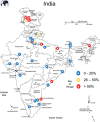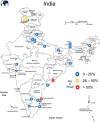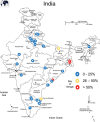Prevalence and Risk Factors of Soil-Transmitted Helminthic Infections in the Pediatric Population in India: A Systematic Review and Meta-Analysis
- PMID: 37064993
- PMCID: PMC10104723
- DOI: 10.1055/s-0042-1751319
Prevalence and Risk Factors of Soil-Transmitted Helminthic Infections in the Pediatric Population in India: A Systematic Review and Meta-Analysis
Abstract
Soil-transmitted helminths (STH) is a major healthcare challenge in the pediatric age group affecting poor and deprived parts of our community. The main species that infect people are roundworm (AL, Ascaris lumbricoides ), whipworm (TT, Trichuris trichiura ), and hookworms (HW, Ancylostoma duodenale and Necator americanus ). We aimed to estimate the pooled prevalence of STH infections in India in the pediatric age group (< 18 years) and assess the risk factors associated with STH in this age group. Three databases were searched (PubMed, Scopus, and Embase) up to February 16, 2021 with deliberate and inclusive search terms for original research articles estimating the prevalence of either of the three STH in India. Data extracted included individual prevalence of the three STH, prevalence of double or triple infections, and associated risk factors. We identified systematically 1,408 publications, of which 44 were included for the final analysis, including studies from 20 states covering 34,590 children. In our study, the prevalence of AL ranged from 0.8 to 91% with a pooled prevalence of 25%, prevalence of TT ranged from 0.3 to 72% with a pooled prevalence of 13%, and for HW prevalence ranged from 0.2 to 80% with pooled prevalence of 10%. Two most important risk factors with higher odds ratio were open defecation practices or open latrine (odds ratio: 5.2) and washing hands without soap using water only (odds ratio: 2.49). Knowledge of areas with high prevalence of STH and associated risk factors would help in designing effective control strategies in the high-risk groups to prevent infection and aid in a drastic reduction of morbidity in children.
Keywords: Ascaris; Trichuris; hookworm; prevalence; soil-transmitted helminth.
The Indian Association of Laboratory Physicians. This is an open access article published by Thieme under the terms of the Creative Commons Attribution-NonDerivative-NonCommercial License, permitting copying and reproduction so long as the original work is given appropriate credit. Contents may not be used for commercial purposes, or adapted, remixed, transformed or built upon. ( https://creativecommons.org/licenses/by-nc-nd/4.0/ ).
Conflict of interest statement
Conflict of Interest None declared.
Figures






Similar articles
-
Prevalence of Soil-Transmitted Helminthes and Associated Risk Factors Among People of Ethiopia: A Systematic Review and Meta-Analysis.Infect Dis (Auckl). 2022 Mar 26;15:11786337211055437. doi: 10.1177/11786337211055437. eCollection 2022. Infect Dis (Auckl). 2022. PMID: 35356097 Free PMC article.
-
Prevalence and risk factors of soil-transmitted helminth infection in Nepal.Trans R Soc Trop Med Hyg. 2014 Apr;108(4):228-36. doi: 10.1093/trstmh/tru013. Epub 2014 Jan 31. Trans R Soc Trop Med Hyg. 2014. PMID: 24488979
-
What does soil-transmitted helminth elimination look like? Results from a targeted molecular detection survey in Japan.Parasit Vectors. 2020 Jan 8;13(1):6. doi: 10.1186/s13071-019-3875-z. Parasit Vectors. 2020. PMID: 31915050 Free PMC article.
-
Interventions to improve disposal of child faeces for preventing diarrhoea and soil-transmitted helminth infection.Cochrane Database Syst Rev. 2019 Sep 24;9(9):CD011055. doi: 10.1002/14651858.CD011055.pub2. Cochrane Database Syst Rev. 2019. PMID: 31549742 Free PMC article.
-
A systematic review and meta-analysis of human and zoonotic dog soil-transmitted helminth infections in Australian Indigenous communities.PLoS Negl Trop Dis. 2022 Oct 24;16(10):e0010895. doi: 10.1371/journal.pntd.0010895. eCollection 2022 Oct. PLoS Negl Trop Dis. 2022. PMID: 36279298 Free PMC article.
Cited by
-
Assessing the impact of the COVID-19 pandemic on neglected tropical diseases in India: a perspective.Front Public Health. 2024 Dec 18;12:1366484. doi: 10.3389/fpubh.2024.1366484. eCollection 2024. Front Public Health. 2024. PMID: 39744363 Free PMC article. Review.
-
Impact of soil-transmitted helminths infections on anemia burden: a global analysis of children under five and reproductive-age women.BMC Public Health. 2025 Apr 11;25(1):1356. doi: 10.1186/s12889-025-22572-z. BMC Public Health. 2025. PMID: 40217491 Free PMC article.
-
Efficacy and Safety of Albendazole Versus Albendazole and Ivermectin in Reduction of Soil-Transmitted Helminth Infections in School-Age Children (DVERMIN): A Double-Blind, Randomized, Controlled Trial.Cureus. 2025 Feb 17;17(2):e79152. doi: 10.7759/cureus.79152. eCollection 2025 Feb. Cureus. 2025. PMID: 40125167 Free PMC article.
-
An antecedental approach in prevalence analysis of CBD parasites from rural population of eastern part of Meghalaya, India.J Parasit Dis. 2025 Jun;49(2):306-312. doi: 10.1007/s12639-024-01752-5. Epub 2024 Nov 4. J Parasit Dis. 2025. PMID: 40458514
-
Soil-transmitted helminths: A critical review of the impact of co-infections and implications for control and elimination.PLoS Negl Trop Dis. 2023 Aug 10;17(8):e0011496. doi: 10.1371/journal.pntd.0011496. eCollection 2023 Aug. PLoS Negl Trop Dis. 2023. PMID: 37561673 Free PMC article. Review.
References
-
- Soil-transmitted helminth infections [Internet]. Accessed June 12, 2022 from:https://www.who.int/news-room/fact-sheets/detail/soil-transmitted-helmin...
-
- Global burden | Global Atlas of Helminth Infections [Internet]. Accessed June 12, 2022 from:http://www.thiswormyworld.org/worms/global-burden
Publication types
LinkOut - more resources
Full Text Sources

